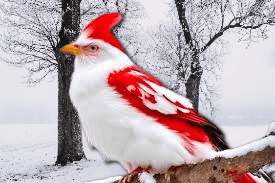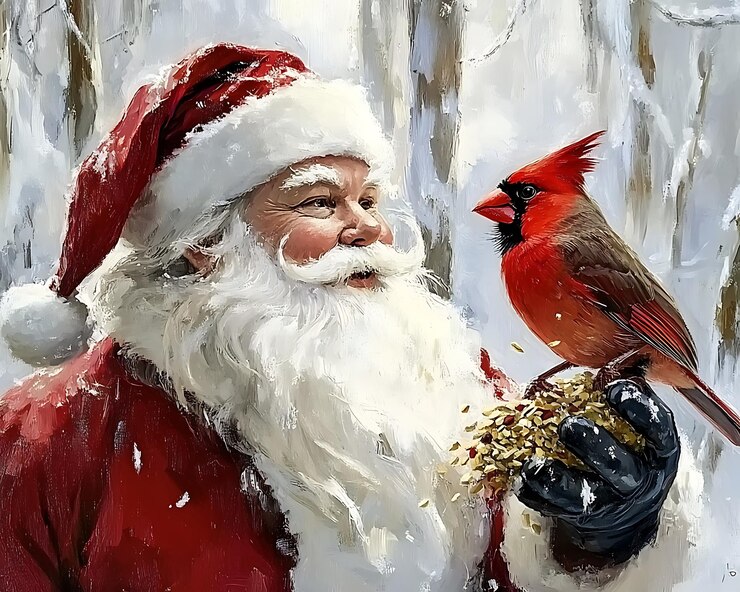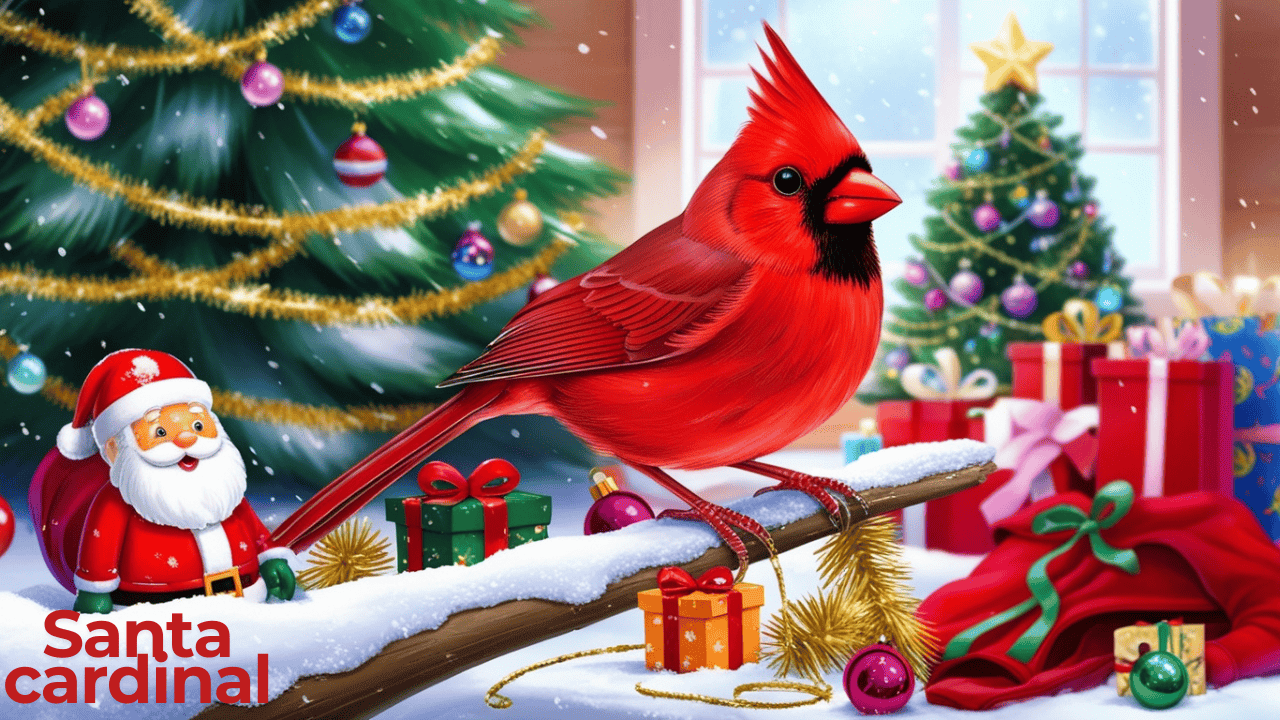The Santa cardinal, known for its vibrant red plumage and distinct connection to winter cheer, has become a symbol of joy for many during the holiday season. This beautiful bird has not only captured the attention of bird enthusiasts but also found its way into festive traditions. With feathers as red as Santa’s coat, this unique species embodies both natural beauty and cultural significance.
Introduction to Santa Cardinal
The Santa Cardinal has become an enchanting figure in nature and culture, often linked with Christmas and winter festivities. Known by bird watchers as a variety of the Northern Cardinal, the Santa Cardinal has gained its whimsical name due to its resemblance to Santa Claus, specifically because of its bright red plumage and cheerful demeanor. You might spot one of these elegant birds perched on a snowy branch, adding a splash of color to the winter landscape, making it easy to understand why people associate it with festive joy.
Throughout this article, we will dive deep into everything you need to know about the Santa Cardinal, from its biology and behavior to its spiritual symbolism and role in holiday celebrations.
What is the Santa Cardinal?
The Santa Cardinal is not a scientifically distinct species but a playful term that refers to the male Northern Cardinal (Cardinalis cardinalis), which stands out for its vivid red plumage and festive look. During winter, these birds often draw attention because their bright color contrasts with the stark white snow. This phenomenon has given rise to a belief that spotting a cardinal in winter brings good luck and happiness—aligning perfectly with the holiday spirit.
Why is it Called a Santa Cardinal?
The name “Santa Cardinal” originates from two symbolic associations:
- The Bird’s Red Feathers: The bright red color of male cardinals resembles Santa’s suit, evoking a sense of warmth and joy during the colder months.
- Winter Sightings: Cardinals remain active and visible during the winter, unlike many migratory birds. Their presence during the holiday season aligns them with symbols of Christmas and festivity.
Physical Characteristics of the Santa Cardinal
Male Santa Cardinals boast brilliant red feathers that make them easy to spot against snow-covered landscapes. Female cardinals, in contrast, display more subtle hues of brown with tinges of red on their wings and crest.
- Size: Cardinals typically measure between 8 to 9 inches in length.
- Distinct Crest: Both males and females feature a prominent head crest, adding to their majestic appearance.
- Black Face Mask: Males have a distinctive black mask around their eyes and beak, which adds to their charm.
Where Can You Find Santa Cardinals?

Santa Cardinals are native to North America, with a range spanning from southern Canada to northern Argentina. They thrive in various habitats, including:
- Woodlands and forests
- Suburban backyards and parks
- Gardens with bird feeders
Because they do not migrate, cardinals remain present throughout the winter, making them a common sight during the holiday season.
What Do Santa Cardinals Eat?
These festive birds have a diverse diet that includes both plants and small insects. Some of their favorite foods include:
- Seeds and grains (especially sunflower seeds)
- Berries such as holly and dogwood
- Insects like beetles and caterpillars
During winter, they often rely on bird feeders for food since natural sources are scarce.
Symbolism of Santa Cardinals in Winter
Santa Cardinals are often seen as symbols of hope, love, and renewal. Many cultures believe that spotting a cardinal during winter is a reminder to stay positive, even in challenging times. Some other symbolic meanings include:
- Good Fortune: Seeing a cardinal during the holidays is believed to bring good luck.
- Spiritual Messages: In some traditions, a cardinal is considered a messenger from loved ones who have passed, offering comfort to those grieving during the holiday season.
- Joy and Celebration: Their bright appearance in the bleak winter landscape reflects the need to find joy even in the darkest days.
How to Attract Santa Cardinals to Your Yard
Bringing these festive birds into your garden is easy with a few thoughtful steps:
- Install a bird feeder with sunflower seeds, safflower seeds, or millet.
- Provide water through birdbaths, especially during winter when natural water sources freeze.
- Plant shrubs and berry-producing plants like dogwood, winterberry, and elderberry.
- Create sheltered spaces with evergreen trees and thick bushes to protect them from predators.
The Santa Cardinal’s Role in Christmas Traditions

In recent years, the Santa Cardinal has become a beloved figure in Christmas decorations and cards. Here’s how it has made its way into holiday traditions:
- Christmas Ornaments: Red cardinal ornaments are a popular addition to Christmas trees.
- Holiday Cards: Many greeting cards feature images of cardinals in snowy settings, spreading messages of joy and peace.
- Winter Decor: Wreaths adorned with faux cardinals symbolize warmth and welcome during the cold months.
Santa Cardinal as a Symbol of Hope During the Holidays
It’s no surprise that the Santa Cardinal has become a beacon of hope during the holiday season. For many people, the cardinal represents loved ones watching over them, particularly those who have passed away. During winter—when nature often feels still and lifeless—the sight of a cardinal reminds us that life and beauty continue to thrive.
How the Santa Cardinal Became a Pop Culture Icon
Beyond holiday traditions, the Santa Cardinal has also found its place in popular culture. The bird’s vibrant imagery frequently appears in:
- Holiday-themed clothing and accessories
- Home decor items like pillows, throws, and tableware
- Social media posts celebrating winter scenes and holiday cheer
What Makes the Santa Cardinal Special?
The combination of natural beauty and symbolic meaning makes the Santa Cardinal a special bird. Few other species capture the festive spirit as perfectly, with their red feathers and cheerful presence offering a visual reminder of the joys of winter and Christmas.
Conclusion
The Santa Cardinal, with its vivid red feathers and symbolic significance, has become a cherished part of winter and holiday celebrations. Whether you view it as a messenger of joy, a symbol of hope, or simply a beautiful creature, this bird brings color and warmth to the coldest season. By inviting these stunning birds into your garden or home decor, you can embrace the spirit of the Santa Cardinal and the cheer it represents.
FAQ
What does it mean to see a Santa Cardinal in winter?
Seeing a Santa Cardinal during winter is often viewed as a sign of good luck, joy, or even a spiritual message from a loved one.
Do female santa cardinal look the same as males?
No, female cardinals are brown with red highlights, while males are bright red with black face masks.
Can I attract santa cardinal to my backyard?
Yes, by offering sunflower seeds, planting berry bushes, and providing water, you can attract cardinals to your yard.
Are santa cardinal migratory birds?
No, Santa Cardinals do not migrate. They remain active and visible throughout the year, including winter.
What do santa cardinal symbolize during the holidays?
Santa Cardinals symbolize hope, love, and renewal, making them a fitting emblem for the holiday season.
Why are santa cardinal associated with Christmas?
Their bright red color and presence during winter have linked them to Christmas traditions and decorations.














